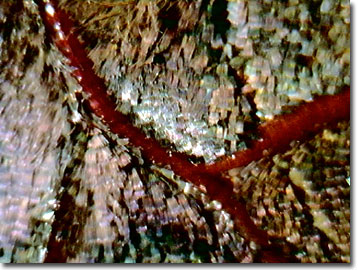Butterfly Wing Scale Digital Image Gallery
Stinky Leaf Wing Butterfly
Although not considered a widely migrating species, stinky leaf wings are occasionally observed flying in huge mixed flocks of migratory butterflies. The robust lepidopterans scientifically classified as Historis odius are native to Central and South America and are island hoppers that can move from island to island in the Caribbean, establishing new populations. Similar to the proverbial fish that got away, the cryptic underside coloration of the species can make stinky leaf wing butterflies difficult to catch and tales are often told of near captures.

Alternatively known as the Orion, the stinky leaf wing butterfly is not always difficult to discern from its environment. The upper surfaces of its wings are a chocolate brown, highlighted by large inner panels of burnt orange that glow in the sunlight and a white spot that marks the apex of each forewing. Sturdy and stout, Orion the hunter is an apt namesake for these butterflies, which on occasion are observed playing in mock combat. Three or four of the swift insects often fly to great heights chased by an assailant and then, suddenly, break apart their formation and return to their bases, or perches, without injury. The sounds of males crashing into the vegetation of the forest canopy, as they chase other butterflies or birds for long distances and at great speeds, can be heard frequently in South America and suggests their tenacious territoriality.
In the larval stage, stinky leaf wing butterflies appear menacing and exhibit various self-protective behaviors. Early larval instars are white with three rows of black spines, a black head, and a short pair of coronal spines. As a guard against ants, which often inhabit the host plant, the young caterpillars produce frass chains along leaf edges. By the second and third instars, the stinky leaf wing caterpillar's head is reddish brown with black markings and features two coronal horns that are accompanied by several long white spines. The fully mature stinky leaf wing caterpillar has an enlarged black thorax that blends in with its small head and is marked by two large white false eyespots that can convey the image of a larger, more imposing animal. The caterpillar's body also displays a black and yellow warning coloration that indicates its unpalatable nature and menacing white-tipped spines that further guard the body from attack. If the caterpillar is threatened, a ventral neck gland, similar in function to the osmeteria of papilionid butterflies, may be everted to emit a defensive chemical.
After twenty days as a caterpillar, the stinky leaf wing enters the pupal stage. The red-brown chrysalis is elongate and sharply compressed laterally with a prominent dorsal ridge, two long, knobby horns, and a very broad cremaster, which terminates in a point. Lateral black bands on each side of the chrysalis indicate the location of the abdominal spiracles. When disturbed, the pupa wiggles like a fish out of water, thus explaining the local Costa Rican name pescadillo, meaning small fish, for this life stage of the butterfly species.
Stinky Leaf Wing Butterfly Images in Brightfield Illumination
Wing Scale Array - This photomicrograph displays the heavily ridged wing scales of a stinky leaf wing butterfly under high magnification. The number and depth of the v-shaped ridges that line the edge of the structures vary.
Stinky Leaf Wing Butterfly Images in Reflected Light
Upper Side of Wing - Reflected light clearly reveals the thick fur that covers the surface of the stinky leaf wing butterfly. The burnt orange color displayed here is typical of the inner panels that are featured on the upper sides of their wings.
Underside of Wing - Purplish hued wing scales and a brownish veil of fur are exhibited in this photomicrograph. The dark earthy colors are characteristic of the undersides of a stinky leaf wing butterfly's wings.
Wing Scales and Vein (Low Magnification) - Tiny rainbows of color can be seen highlighting the earth-tone scales of a stinky leaf wing butterfly in this low magnification image. A twig-like vein runs diagonally across the bottom right hand corner of the image.
Wing Scales and Vein (Medium Magnification) - This image was captured under a higher level of magnification than the previous photomicrograph. The cryptic wing vein is now much more prominent and the scales take on greater definition.
Wing Scales and Vein (High Magnification) - The wing scales and vein of the previous image are displayed here under a slightly increased level of magnification. The shape and color of the wing vein is beautifully revealed.
Edge of Wing - This low magnification image displays the edge of a stink leaf wing butterfly's wing. A few of the delicate scales appear to have fallen out of place.
Contributing Authors
Cynthia D. Kelly, Shannon H. Neaves, Laurence D. Zuckerman, and Michael W. Davidson - National High Magnetic Field Laboratory, 1800 East Paul Dirac Dr., The Florida State University, Tallahassee, Florida, 32310.
BACK TO THE BUTTERFLY WING SCALE IMAGE GALLERY
BACK TO THE DIGITAL IMAGE GALLERIES
Questions or comments? Send us an email.
© 1995-2025 by Michael W. Davidson and The Florida State University. All Rights Reserved. No images, graphics, software, scripts, or applets may be reproduced or used in any manner without permission from the copyright holders. Use of this website means you agree to all of the Legal Terms and Conditions set forth by the owners.
This website is maintained by our
Graphics & Web Programming Team
in collaboration with Optical Microscopy at the
National High Magnetic Field Laboratory.
Last Modification Friday, Nov 13, 2015 at 01:19 PM
Access Count Since January 21, 2003: 20703
Visit the website of our partner in introductory microscopy education:
|
|
